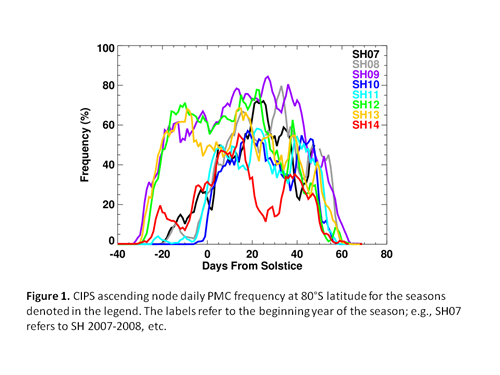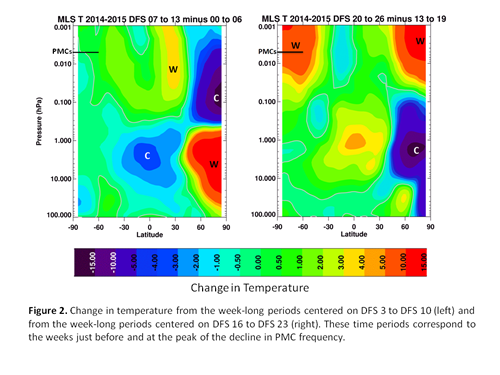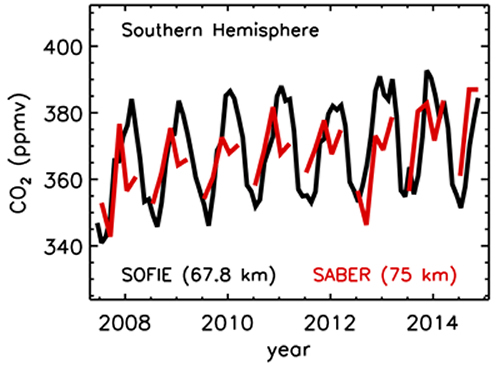|
STATUS:
03.09.2015
Instrument Status:
The AIM spacecraft continues to perform well. All subsystems are operating as expected. During the past few months the Flight Operations Team has been developing ground system autonomy for the purpose of performing Relative Time Sequence loads. This autonomy was rolled out after the first of the year and has been successful in performing the initial upload of command sequences which will be necessary to keep AIM functioning in mitigation of the ever increasing beta-angle (angle toward the sun) caused by orbit precession.
There is an eclipse of the sun by the moon later this month (March 20) and AIM will be transitioning to its alternate control mode to prevent issues with the primary control mode's handling of such eclipses.
CIPS:
The CIPS instrument continues to perform well, with no health issues. CIPS saw the last clouds of the SH 2014-2015 season on 20 February. Figure 1 shows the CIPS daily PMC frequencies for each SH season observed so far by AIM. The SH 2014-2015 season (SH14 in the legend) was an intriguing one. Overall the cloud frequencies were somewhat lower than in many other seasons, and there was a substantial decline around 15-25 days from solstice (DFS).

click image to enlarge
Figure 2 provides evidence that this mid-season decline in PMCs in 2015 was caused by interhemispheric teleconnections. The left panel of Figure 2 shows the quadrupole structure in the temperature field that is typical of wintertime polar stratospheric warming. That is, there is planetary wave-driven warming in the winter (NH in this case) polar stratosphere, and cooling above; this is accompanied by cooling at lower latitudes in the stratosphere, and warming above. It has been shown by numerous authors that this pattern precedes a warming in the summer polar mesopause region and consequent decline in PMC frequency [e.g., Karlsson et al., 2009]. The right panel of Figure 2 shows the recovery from the winter stratospheric warming, and the accompanying warming that occurs in the summer polar mesopause region. This summertime warming is the result of complex wind-wave interactions that ultimately result in a reduced residual circulation, a warmer summer polar mesopause, and a decline in PMCs.

click image to enlarge
SOFIE:
The SOFIE instrument continues to operate normally. Recent efforts have used signal averaging to reduce the noise in SOFIE refraction-based temperature / pressure retrievals at higher altitudes. This procedure moves the highest refraction retrieval altitudes obtained from ~50 to ~68 km, in the current scheme. A primary motivation for this is to allow SOFIE CO2 retrievals to extend to higher altitudes. The initial results are encouraging, and retrievals have been performed on the SOFIE data from 2007 - present. NASA SABER data have been used to retrieve CO2 mixing ratio profiles covering 2002 to present over a broad latitude range and altitudes from ~75 and 110 km. Comparison of SOFIE and SABER results indicate good agreement at altitudes where the data sets are in close proximity (see figure below). More importantly, the multi-year SOFIE and SABER CO2 observations allow the calculation of CO2 increase rates over a broad vertical range of the atmosphere. With the current data sets, both SOFIE and SABER infer CO2 increases of ~2 ppm / year, the former at polar latitudes from 30-68 km and the latter a global average from 80-100 km. This trend is slightly lower than the initial report of 2.3 ppmv yr-1 at 90-105 km by Emmert et al [2012] using data from the Atmospheric Chemistry Experiment, but is in good agreement with surface trends (e.g http://www.esrl.noaa.gov/gmd/ccgg/trends/). Taken together, these datasets illustrate the propagation of anthropogenic greenhouse gas emissions from the lower atmosphere to the lower thermosphere.

click image to enlarge
|
